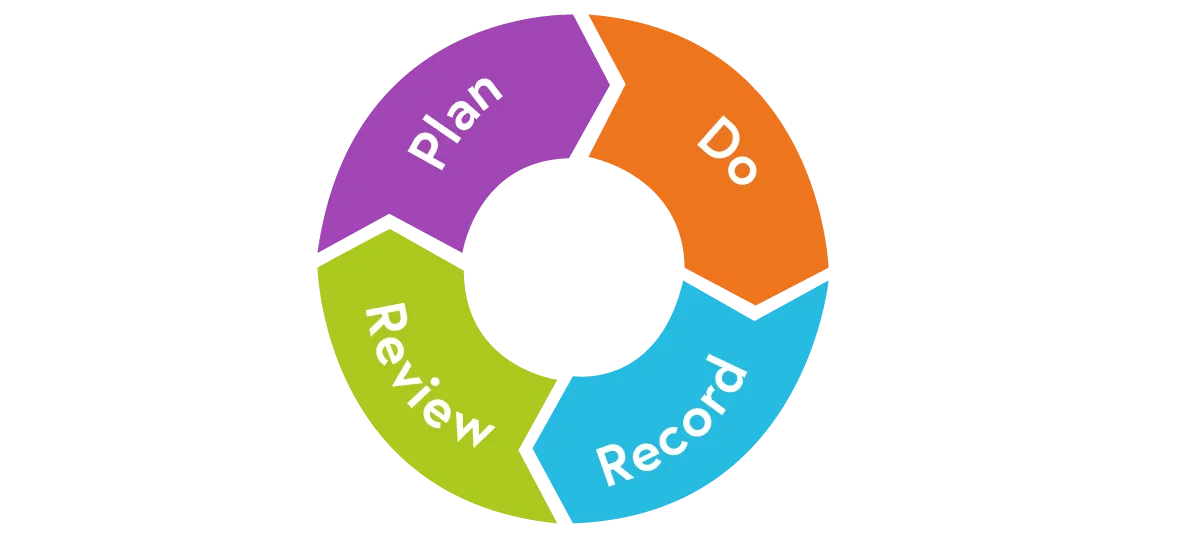
- Identify your short-term goals: think about what needs to happen for you to reach them. You may need to learn a new skill on a technical course, gain experience by job shadowing or take on more responsibility by training others. You might want to use your last appraisal, your CV or your current job description for ideas. However you do it, you should end up with a list of things to do.
Not sure how to define your goals? An IET Mentor could help. - Work out what steps on your to-do list need to be done first: what resources do you need (like books and courses) and who can help you? For more ideas, check out our ‘What counts as CPD?’ web page.
You’ll need to ensure you meet the minimum 30 hours per calendar year if you’re a professionally active Member (semi-retired or partially-active members have a reduced target of 10 hours). - Think about how you’ll measure your achievements for each objective and give yourself a realistic target date. It’s also worth setting a review date (say in 6 to 12 months) and putting it in your diary to give you something to work towards.
- Get all the materials, financing and resources you need together and make time in your schedule for learning. Use Career Manager to make a note of how many CPD hours you do and the type of activity you choose for each goal.
- If anyone is helping you (a manager, colleague or mentor), get them on board. Don’t be afraid to ask for help, just be clear about what you need and keep them updated on your progress.
- Find a way to learn that suits you. Some people like to understand the theory before trying something while others like to experiment and learn in a more hands-on way.
Find out what works for you - the more you enjoy what you’re doing, the more you’ll learn.
- Take time to reflect: After each activity, take some time to reflect on what you’ve learned and how it affected your approach by recording it in your logbook. Make a note of things you feel went well, any things that you could have done differently or better, and whether they met your needs or if there are other things you need to do to reach your goal.
Don’t forget to record your CPD hours and the type of activity in Career Manager. - Go back to your logbook at regular intervals and review the knowledge you’ve gained: Every month or so, you should look back at your log and think about how your new knowledge will affect your performance at work, how it will make you better at your job and what you might want to change based on what you’ve learned.
It doesn’t have to be a chore – a few lines or paragraphs is enough – and you can always ask your mentor or line manager for their thoughts too. - If you’re using competencies, decide which competence each piece of your learning is linked to: Record your new level and chart your progress. Collect evidence (such as references) as you go and upload them to your portfolio so you can easily find each one.
- Use your review date to assess your achievements: When you’ve reached the review date you set when you were planning, give yourself some time to go through everything you’ve achieved so far. Look at your logbook and tick off all the goals you’ve reached and think about the ones still on your to-do list.
Don’t forget to remove any irrelevant ones and update any that need a refresh for the next few months ahead. - Start planning again! Move your medium-term goals to become part of your short-term plan for the next period, and check in with your longer-term objectives to make sure they’re up to date.
Don’t forget, as a professionally active Member, you should aim to undertake a minimum of 30 hours of CPD per calendar year.
We’re upgrading our systems, and this includes changes to our customer and member account log in, MyIET. It’s part of our big picture plan to deliver a great experience for you and our wider engineering community.
Whilst most of our websites remain available for browsing, it will not be possible to log in to purchase products or access services from Thursday, 17 April to Wednesday, 30 April 2025. Our Member Relations team is here to help and for many of our services, including processing payments or orders, we’ll be able to support you over the phone on +44 (0)1438 765678 or email via membership@theiet.org.
We apologise for any inconvenience this may cause and thank you for your understanding.
For further information related to specific products and services, please visit our FAQs webpage.
